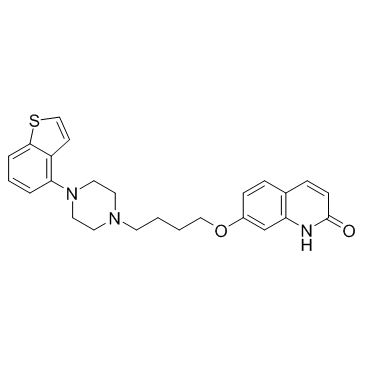913611-97-9
| Name | 7-[4-[4-(1-benzothiophen-4-yl)piperazin-1-yl]butoxy]-1H-quinolin-2-one |
|---|---|
| Synonyms |
unii-2j3ybm1k8c
OPC-34712 7-{4-[4-(1-benzothiophen-4-yl)piperazin-1-yl]butoxy}quinolin-2(1H)-one Rexulti brexpiprazole 7-{4-[4-(1-Benzothiophen-4-yl)-1-piperazinyl]butoxy}-2(1H)-quinolinone |
| Description | Brexpiprazole is a partial agonist of human 5-HT1A and dopamine receptor with Kis of 0.12 nM and 0.3 nM, respectively. Brexpiprazole is also a 5-HT2A receptor antagonist with a Ki of 0.47 nM. |
|---|---|
| Related Catalog | |
| Target |
Ki: 0.12 nM (5-HT1A), 0.3 nM (D2L), 0.47 nM (5-HT2A)[1] |
| In Vitro | Brexpiprazole, a novel serotonin-dopamine activity modulator: A role for serotonin 5-HT1A and 5-HT2A receptors. Brexpiprazole also shows potent antagonist activity at human nor adrenergic α1B (Ki=0.17 nM) and α2C receptors (Ki=0.59 nM). Brexpiprazole significantly potentiates nerve growth factor (NGF)-induced neurite outgrowth in PC12 cells, in a concentration dependent manner. Brexpiprazole (1 μM) increases the number of cells with neurites in PC12 cells. Treatment with Brexpiprazole (0.001, 0.01, 0.1 or 1.0 μM) in conjunction with NGF (2.5 ng/mL) increases the number of cells with neurites, in a concentration-dependent manner[1]. |
| In Vivo | Brexpiprazole (0.01, 0.03, 0.1 mg/kg, p.o.) significantly ameliorates dizocilpine-induced social recognition deficits, without sedation or a reduction of exploratory behavior. In addition, Brexpiprazole alone has no effect on social recognition in untreated controlmice. By contrast, neither Risperidone(0.03 mg/kg, p.o.) nor Olanzapine (0.03 mg/kg, p.o.) alters Dizocilpine induced social recognition deficits. Finally,the effect of Brexpiprazole on Dizocilpine-induced social recognition deficits is antagonized by WAY-100,635. These results suggest that Brexpiprazole can improve Dizocilpine-induced social recognition deficits via 5-HT1A receptor activation in mice[2]. |
| Cell Assay | PC12 cells are cultured at 37°C, 5% CO2 in Dulbecco's modified Eagle's medium (DMEM), supplemented with 5% heat-inactivated fetal bovine serum (FBS),10% heat-inactivated horse serum, and 1% penicillin-streptomycin. Medium is changed two to three times a week. PC12 cells are plated onto 24- well tissue culture plates coated with poly-D-lysine/laminin. Cells are plated at relatively low density (0.25×104 cells/cm2) in DMEM medium containing 0.5% FBS,1% penicillin-streptomyc in Medium containing a minimal level of serum (0.5% FBS) is used. In this study, 2.5 ng/mL of NGF is used to study the potentiating effects of Brexpiprazole on neurite outgrowth. Twenty-four hours after plating, the medium is replaced with DMEM medium containing 0.5% FBS and 1% penicillin-streptomycin with NGF (2.5 ng/mL), with or without Brexpiprazole (0.001,0.01,0.1 or 1 μM), WAY-100,635 (5-HT1A receptor antagonist;10 μM), raclopride (dopamine D2 receptor antagonist;10 μM), DOI (5-HT2A receptor agonist;0.1,1 or 10 μM), M100,907 (5-HT2A receptor antagonist; 0.1, 1 or 10 μM), xestospongin C (IP3 receptor antagonist; 1 μM), 2-APB (IP3 receptor antagonist;100 μM), fluoxetine (5-HT transporter inhibitor: 1 μM), or paroxetine (5-HT transporter inhibitor: 1 μM). Four days after incubation with NGF (2.5ng/mL) with or without specified drugs, morphometric analysis is performed on digitized images of live cells taken under phase-contrast illumination, with an inverted microscope linked to a camera. Images of three fields per well are taken, with an average of 100 cells per field. Differentiated cells are counted by visual examination of the field; only cells that had at least one neurite with a length equal to the cell body diameter are counted, and are then expressed as a percentage of the total cells in the field. Counting is performed in ablinded manner[1]. |
| Animal Admin | Mice[2] Male C57BL/6NCrSlc mice aged between 4 and 5 weeks old are selected as stranger mice, while animals between 8 and 10 weeks old are used for this study. All mice are housed in groups of five percage, in a room maintained at 23±2°C and 60±10% humidity, with a 12/12h light/dark cycle (lights on at 7:00 a.m.).The mice are given free access to food and water. Brexpiprazole is dissolved in 5% (w/v) gum Arabic and administered orally (p.o.), at 10 mL/kg, 1 h prior to sociability testing. The doses of antipsychotic drugs are selected based on doses that did not impact locomotion. |
| References |
| Density | 1.2±0.1 g/cm3 |
|---|---|
| Boiling Point | 675.2±55.0 °C at 760 mmHg |
| Molecular Formula | C25H27N3O2S |
| Molecular Weight | 433.566 |
| Flash Point | 362.1±31.5 °C |
| Exact Mass | 433.182404 |
| PSA | 77.07000 |
| LogP | 5.82 |
| Vapour Pressure | 0.0±2.1 mmHg at 25°C |
| Index of Refraction | 1.646 |
| Storage condition | 2-8°C |
